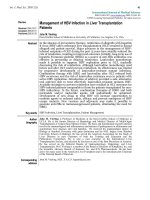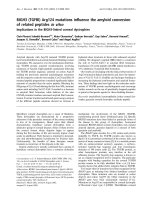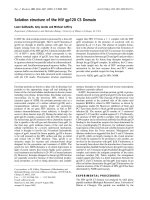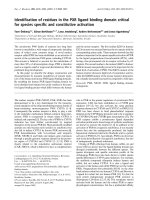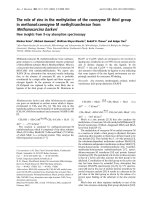Báo cáo y học: " Determining relevant cortisol concentrations in critically ill patients" pptx
Bạn đang xem bản rút gọn của tài liệu. Xem và tải ngay bản đầy đủ của tài liệu tại đây (116.23 KB, 2 trang )
In the previous issue of Critical Care, Cohen and
colleagues [1] conducted a feasibility study and examined
10 burn patients and 3 healthy volunteers to determine
whether there were correlations between tissue cortisol
levels and plasma-free cortisol levels. e authors
hypothesized that tissue cortisol levels are more relevant
as this is what binds to cellular cortisol receptors and
leads to cortisol-associated physiological changes seen.
e authors concluded that obtaining tissue cortisol
levels was feasible, but there was no correlation between
tissue and plasma cortisol levels.
Diff erent methods of measuring cortisol levels are
used. e most commonly used method measures total
serum cortisol, which is free and protein (transcortin and
albumin)-bound cortisol. Measuring total cortisol has
poor sensitivity and specifi city and high variability in
critically ill patients [2]. In addition, the immunoassays
used to determine total cortisol are subject to inter-
ference, with heterophile antibodies present in some
critically ill patients [3]. Using mass spectroscopy to
measure cortisol is more specifi c though not widely
available. Some have suggested using ratios like the free
cortisol index [4] to calculate the free cortisol amount;
however, these methods do not account for all proteins
such as albumin, they require measurement of
transcortin (a lab test not widely available), and they do
not adequately account for any dilutional eff ects of
massive resuscitation or of other hormonal changes (for
example, vasopressin) that may aff ect plasma cortisol
levels [5]. Cosyntropin stimulation testing has been
advocated by some [6-8] to determine whether there is
relative adrenal insuffi ciency; however, the values used as
a standard for ‘inadequate response’ were determined in
healthy adults (not critically ill patients), and there is still
a high level of variability in measurements, even in the
same patient [9,10]. e most accurate active cortisol
measure that is clinically relevant is serum-free cortisol
[9,11]. Measuring serum-free cortisol, however, is very
diffi cult to perform and thus is not widely available. A
widely available and less costly test that does correlate
well with plasma-free cortisol levels is to measure salivary
cortisol levels [12]. However, it is diffi cult to get an
adequate saliva sample in critically ill patients [13].
e study of Cohen and colleagues [1] is one of the fi rst
to examine tissue cortisol levels. Although measuring
tissue cortisol may be more pathophysiologically relevant
than measuring plasma levels, it is not clear how
measuring cortisol levels in tissues relates to relevant
outcomes of decreased vasopressor use and improved
mortality. ere have been many studies examining
plasma cortisol levels and relating them, or treatment of
relative adrenal insuffi ciency, with relevant outcomes
[6,7]. To our know ledge, there are no studies linking
tissue cortisol levels to relevant outcomes. It is known
that there is tissue resis tance to glucocorticoids,
potentially due to local cyto kine production leading to
downregulation and decreased affi nity of glucocorticoid
receptors and post-receptor alterations [14]. us,
cortisol levels may be very diff erent in diff erent tissues,
raising the question of what tissue the cortisol should be
measured in. With massive resusci tation, tissues can also
become very edematous and this may dilute tissue
Abstract
The importance of adrenal function to survival in
critically ill patients has been established; however,
identifying the best method to diagnose adrenal
insu ciency has been problematic. Multiple methods
of determining adrenal function have been developed,
each with its advantages and disadvantages.
Serum-free cortisol levels are probably the most
accurate, although obtaining this result is technically
demanding. Cohen and colleagues investigated the
feasibility of measuring tissue cortisol levels in burn
patients and whether tissue cortisol levels could be
used as a surrogate for plasma-free cortisol levels.
© 2010 BioMed Central Ltd
Determining relevant cortisol concentrations in
critically ill patients
Rizwan A Manji and Anand Kumar*
See related research by Cohen et al., />COMMENTARY
*Correspondence:
Cardiac Sciences Program, I. H. Asper
Clinical Research Institute
, CR3014-369
Taché
Avenue
, Winnipeg, MB, Canada, R2H 2A6
Manji and Kumar Critical Care 2010, 14:113
/>© 2010 BioMed Central Ltd
cortisol levels, again raising the ques tions of when to
obtain tissue cortisol levels, where to obtain the levels,
and the accuracy of the result. Cortisol has eff ects on
gluconeogenesis, vascular tone, endothelial integrity, and
angiotensinogen synthesis and has anti-infl ammatory
eff ects on the immune system [15]. All of these eff ects of
cortisol aff ect the entire organism, suggesting that
measuring circulating cortisol, rather than tissue cortisol,
may be more relevant and useful from a clinical point of
view. Eff orts should continue to determine more effi cient
and eff ective ways to measure serum-free cortisol levels
or related markers so that these assays can be widely used
in a way that can benefi t critically ill patients in the
intensive care unit.
Competing interests
The authors declare that they have no competing interests.
Published: 8 February 2010
References
1. Cohen J, Deans R, Dalley A, Lipman J, Roberts M, Venkatesh B: Measurement
of tissue cortisol levels in patients with severe burns: a preliminary
investigation. Crit Care
2009, 13
:
R189.
2. Clark PM, Neylon I, Raggatt PR, Sheppard MM, Steward PM: De ning the
normal cortisol response to the short synacthen test: implications for the
investigation of hypothalamic-pituitary disorders. Clin Endocrinol (Oxf)
1998, 49:287-292.
3. Bolland MJ, Chiu WW, Davidson JS, Croxson MS: Heterophile antibodies may
cause falsely lowered serum cortisol values. J Endocrinol Invest 2005,
28:643-645.
4. Le Roux CW, Chapman GA, Kong WM, Dhillo WS, Jones J, Alaghband-Zadeh J:
Free cortisol index is better than serum total cortisol in determining
hypothalamic-pituitary-adrenal status in patients undergoing surgery.
JClin Endocrinol Metab 2003, 88:2045-2048.
5. Taylor KM, Bain WH, Jones JV, Walker MS. The e ect of hemodilution on
plasma levels of cortisol and free cortisol. J Thorac Cardiovasc Dis 1976,
72:57-61.
6. Rothwell PM, Udwadia ZF, Lawler PG: Cortisol response to corticotrophin
and survival in septic shock. Lancet 1991, 337:582-583.
7. Annane D, Sebille V, Charpentier C, Bollaert PE, Francois B, Korach JM,
Capellier G, Cohen Y, Azoulay E, Troche G, Chaumet-Ri aut P, Bellissant E:
E ect of treatment with low doses of hydrocortisone and udrocortisone
on mortality in patients with septic shock. JAMA 2002, 288:862-871.
8. Annane D, Sebille V, Troche G, Raphael JC, Gajdos P, Bellissant E: A 3-level
prognostic classi cation in septic shock based on cortisol levels and
cortisol response to corticotropin. JAMA 2000, 283:1038-1045.
9. Hamrahian AH, Oseni TS, Arafah BM: Measurements of serum free cortisol in
critically ill patients. N Engl J Med 2004, 350:1629-1638.
10. Loisa P, Uusaro A, Ruokonen E: A single adrenocorticotropic hormone
stimulation test does not reveal adrenal insu ciency in septic shock.
Anesth Analg 2005, 101:1792-1798.
11. Ho JT, Al-Musalhi H, Chapman MJ, Quach T, Thomas PD, Bagely CJ, Lewis JG,
Torpy DJ: Septic shock and sepsis: a comparison of total and free plasma
cortisol levels. J Clin Endocrinol Metab 2006, 91:105-114.
12. Laudat MH, Cerdas S, Fournier C, Guiban D, Guilhaume B, Luton JP: Salivary
cortisol measurement: a practical approach to assess pituitary-adrenal
function. J Clin Endocrinol Metab 1988, 66:343-348.
13. Nishiyama FJ, Thlaygi H, Zayour DH, Hejal R, Arafah BM: Increased salivary
cortisol concentrations in critically ill patients: a practical approach in
determining free cortisol in the circulation. Program of the 87th Annual
Meeting of the Endocrine Society; 3 to 6 June 2005; San Diego, CA. Abstract
P3-440.
14. Schaaf MJ, Cidlowski JA: Molecular mechanisms of glucocorticoid action
and resistance. J Steroid Biochem Mol Biol 2002, 83:37-48.
15. Arafah BM: Hypothalamic pituitary adrenal function during critical illness:
limitations of current assessment methods. J Clin Endocrinol Metab 2006,
91:3725-3745.
Manji and Kumar Critical Care 2010, 14:113
/>doi:10.1186/cc8225
Cite this article as: Manji RA, KumarA: Determining relevant cortisol
concentrations in critically ill patients. Critical Care 2010, 14:113.
Page 2 of 2
